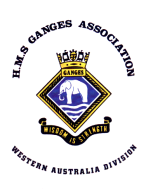
WA DIVISION HOIST NOVEMBER 2017 |
G’day all,
At this time, I am trying to get some semblance of order back into my life following the recent death of my wife Gail. It was our 50th wedding anniversary on Trafalgar Day. Putting this Hoist together will hopefully help me on the journey to bring some normality back into my life. The messages and condolences I have received are much appreciated.
Well it looks like this may not be the final Hoist as we have nominations for the management team to be presented at the AGM. Please note further nominations will be accepted prior to 1700 on 15th November. If there is more than one nomination for any position an election will be held. The management team for 2018 will be confirmed at the AGM. At present it looks like the Management team will consist of President, Vice President, Secretary, Treasurer, and four committee members. The WA Division Rules will need to be changed to reflect decisions made at the AGM.
I am reading “Great Naval Blunders” (History’s worst sea battle decisions from ancient times to the present day) by Geoffrey Regan. First published in 1993 but republished in 2017 the book does not contain some of the more recent naval blunders, none the less it is well worth a read. The author roams the seas of two thousand years of naval misdemeanors, providing in-depth analyses of what went wrong in key naval battles and offers many intriguing and bizarre anecdotes. I have included a couple of cases in the Hoist; Chinese Navy and Ships that torpedoed themselves.
Remaining Gathering for 2017
| Committee Meetings
3rd Thursday of odd month Commencing 1200 @ FNC |
Division Meetings
4th Thursday of odd month Commencing 1200 @ FNC |
Social Sausage Sizzles
4th Sunday of even month Commencing 1200 @ RNC |
| 16th November | AGM 23rd November | |
| Christmas Lunch
1200 Wednesday 13th December at FNC |
||
Social Coordinator Paul’s Hoist;
Social Sausage Sizzle Rockingham Navy Club Sunday 8 October 2017.
A lovely Spring day with early rain clearing nicely. Approaching 30 attendees enjoyed Gary’s cooking and the various accompaniments (thanks to all concerned). It was nice to see Hilary and Morag joining in as they recover from their ills. The food went down, the rum flask passed then on to Cathy’s raffle with Ganges marginally ahead on receiving prizes. Unlucky 13 won a bottle of Pusser’s for me. Some Lamp swinging and time for home.
Trafalgar Dinner.
I believe Les Simmons attended the Trafalgar Dinner and may be kind enough to brief us. (That does not mean attend in your underpants Les).
Quiz Night
I also believe Ganges provided a table for the Quiz night. Perhaps an attendee could let us know how we got on. Anything better than last or second last would be an outstanding result.
UPCOMING EVENTS.
Christmas Lunch.
When 1200 Wednesday 13 December.
Where Fremantle Navy Club.
Details Cost will be around $30 with a similar format to previous years.
Names soonest to me by email jackrubb@optusnet.com.au. further details regarding payment etc. will be provided later.
| We should all be aware of the recent growth of the Chinese Navy as evidenced by China’s first operational aircraft carrier PLAN Chinese Ship Liaoning, commissioned in 2012.
However, in the last years of the 19th Century under the influence of Admiral Ting Ju-chang (Ding Ruchang), the Chinese Navy appeared to be making enormous strides towards modernization. Unfortunately, appearances were deceptive, the war with Japan which broke out in 1894 exposed severe limitations in the efficiency of the Chinese fleet.
|
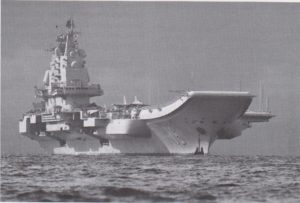
PLAN Chinese ship Liaoning
Discipline aboard Chinese warships maybe judged by the curious form of gambling at pitch and toss which took place, usually involving the sentries. The ships themselves were in a filthy state; the watertight doors were never closed, and the gun barrels were used by the crew as dumps for pickles, rice and chopsticks. One Chinese battleship went into action at the battle of the Yalu River minus one of its heavy guns because Admiral Ting had pawned it. The shells used by the Chinese were sometimes found to be stuffed with charcoal and the gunpowder sold and replaced by cocoa powder. Chinese officers were so terrified of torpedoes that they fired them at twice the proper range with the result that the torpedoes always sank before they had covered half the distance to the target.
![]()
Ships that Torpedoed Themselves:
Weapons systems are generally designed to operate within a range of climatic conditions and if they are exposed to conditions far beyond the norm there is always a danger they will malfunction. If the weapon is offensive in character, then the worst which can usually happen is a failure to strike the enemy. However, there have been two recorded occasions of weapons turning on their masters, and, in one case, inflicting decisive damage. The weapon was the torpedo and the victim the British cruiser HMS Trinidad. On 29 March 1942, Trinidad was escorting convoy PQ13 in Arctic waters when it was attacked by three German destroyers. It was so cold that day that spray froze instantly as it landed on the decks. After an exchange of gunfire Trinidad fired three torpedoes at the Z26, but two of them were so iced up that they failed to leave the tubes. The third torpedo malfunctioned when the oil in its motor and gyroscope froze, causing it to change direction, swing around and return the way it had come. The torpedo hit the cruiser amidships, damaging her severely. It was only with extreme difficulty that Trinidad limped into Murmansk for repairs.
Luckier than Trinidad was the Peruvian ironclad Huascar, when it tried to torpedo the Chilean corvette Abtao in 1879. The Huascar’s commander, Admiral Grau, closed to within 200 yards of the unsuspecting Abtao and fired a torpedo. It travelled straight for about 100yards before suddenly turning to port, making a wide semi-circle and returning straight back towards the Huascar. Lieutenant Diaz Canseco, alive to the danger, leapt overboard, swam towards the torpedo and forced it to change direction with his hands. Admiral Grau was so disgusted with the new weapon; for it was the first time he had ever fired a torpedo; that he took his remaining supply and buried them in a cemetery.
Lloyds Register of Shipping
Towards the latter part of the 17th Century, the commercial community interested in shipping, met at a small coffee house kept by a man named Edward Lloyd, first of all in Tower street and later at the corner of Abchurch Lane and Lombard Street in the City of London. The coffee house became the primary gathering place for merchants, seafaring men and marine insurers.
Edward Lloyd was a man of wisdom and enterprise and founded a system of commercial and maritime intelligence and a newspaper which he called Lloyd’s News. However, Lloyd fell foul of the House of Lords over an article he had written; he was censured and his newspaper suppressed and it was not until 1726 that it was re-established under the name of Lloyd’s List. Lloyd’s List now claims to be the oldest continuously published newspaper in the world.
In 1770, the frequenters of the coffee house, whose particular business was underwriting marine insurance formed themselves into an alliance, ultimately established as the Corporation of Lloyd’s. The underwriters of Lloyd’s found that they needed complete information on the construction and condition of ships in order to ensure them and so was established, Lloyd’s Register of Shipping.
Were they Decoys?
Seventy-five years ago, in November 1942, Britain and America launched Operation TORCH, the ambitious invasion of French North African colonies of Morocco and Algeria. To convey 70,000 troops and their equipment required 350 merchant ships crossing the U-boat infested North Atlantic from the USA and 250 more sailing south from British ports.
The need for a high level of protection for these meant withdrawing large numbers of escorts from the routine trade convoys. Amongst those left without adequate defence were RB 1 and SC 107, both eastbound from America, and SL 125, northbound from Freetown. All three were at sea at the same time as the TORCH convoys. Predictably, Admiral Donitz threw the full weight of his 140 Atlantic U-boat fleet against the now vulnerable trade convoys, which between them lost thirty-one ships and 792 men.
While this unprecedented massacre was in progress, the troop-carrying convoys slipped miraculously through entirely without incident. There is nothing on record to say that the trade convoys RB 1, SC 107 and SL 125 were sacrificed to ensure the safe passage of the TORCH convoys but one can’t help but think this would have been the case.
Australia’s Future Frigates:
The Commonwealth Government recently released Australia’s first Naval Shipbuilding Plan (NSP), outlining the nation’s largest programme of naval shipbuilding and sustainment. Below are the 3 options being considered for the nine future frigates. The chosen option will be promulgated this year, with building to commence in 2020 and delivery of the first frigate from about 2027.
|
Option 1: The Italian frigate Carabiniere |
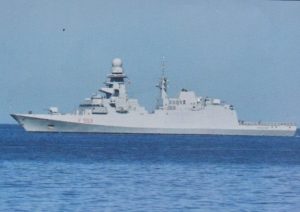 |
Option 2: Spain’s ESPS Cristobal Colon
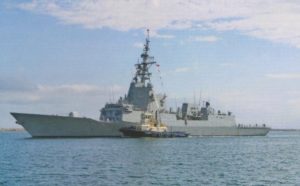
| Option 3: The UK’s Type 26 Frigate |
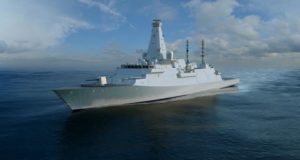
RN Snippits:
Flagship Going:
HMS Ocean, the Royal Navy’s flagship will be decommissioned in 2018, her role will be taken by the two new Queen Elizabeth class aircraft carriers.
Type 31 Frigates:
According to The Times, BAE Systems and Babcock International are expected to bid against each other for a £2bn contract for six Type 31 Frigates. The £2bn contact suggests a cost per ship of around £330m. The new class of frigates will be more affordable than the Type 26. The Type 31 plan is expected to follow a similar pattern to that of the Queen Elizabeth carriers and early Type 45 Destroyers with blocks to be built in yards around the UK and assembled on the Clyde. An independent report into the National Shipbuilding Strategy by Sir John Parker has recommended that the new Type 31 Frigates be built across the UK, with blocks being constructed in yards in both Scotland and England.
Type 26 Frigates:
In July the UK Government gave the green light to BAE Systems to build three of the new Type 26 anti-submarine warfare frigates in a £3.7 billion deal. The contract is for the first batch of a promised fleet of eight such ships to replace the current Type 23 frigates as escorts for the new Queen Elizabeth class aircraft carriers and to protect units of the nuclear submarine fleet as they arrive and depart from their base in Scotland. The first Type 26 is now scheduled to be accepted by the RN around the late 2020’s some years after the first Type 23 frigate, HMS Argyll, is planned to be paid off.
Point to ponder!
Be respectful of all opinions, unless they’re wrong, obviously
That’s all folks;
| Cheers aye – Ian
|


